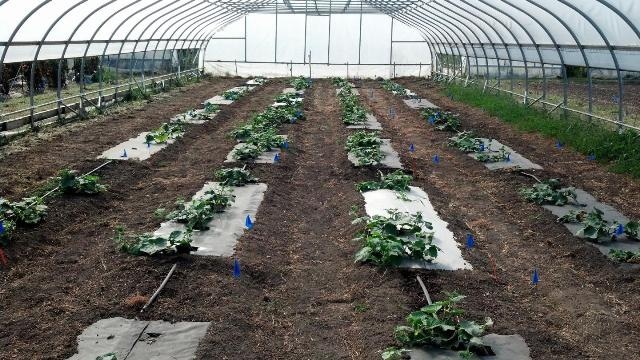Jun 23 2016
The use of polyethylene mulch is a common practice in vegetable production, but environmental issues related to the disposal of petroleum-based plastic mulches have producers looking for alternatives. To address environmental concerns, commercial vegetable growers are increasingly interested in using organic mulches derived from agricultural or urban byproducts and waste, paper-based mulches, and biodegradable plastic films and fabrics as alternatives. A new study comparing bioplastic films with biofabrics indicates that there is good potential for successfully using biofabric under certain growing conditions.
 Six biodegradable mulches were compared in a high tunnel cucumber production system at Urbana, IL, in 2013. Biofabrics showed promise for use in certain environments. (CREDIT: Photo courtesy of Sam Wortman.)
Six biodegradable mulches were compared in a high tunnel cucumber production system at Urbana, IL, in 2013. Biofabrics showed promise for use in certain environments. (CREDIT: Photo courtesy of Sam Wortman.)
To learn more about the field performance, durability, and decomposition properties of biofabric, the researchers designed experiments to compare four experimental spunbond, nonwoven biofabrics with two commercially available bioplastic mulch films and a bare soil control. The experiments were performed in field and high tunnel growing environments with cucumber. The scientists collected data to determine the mulch's impact on soil moisture, soil temperature, crop yield, and weed emergence. All mulches were also analyzed for their durability and ability to decompose when incorporated into the soil.
Results showed that the bioplastics and biofabrics increased soil moisture relative to bare soil. Bioplastic films were less durable and deteriorated sooner than biofabrics, especially in the field environment. All biomulches suppressed weed emergence relative to bare soil, but weeds were visibly growing beneath the most translucent biofabric. Marketable yield of cucumber trended highest in the most durable and opaque biofabric, but was not significantly different from weed-free bare soil.
The scientists found no difference in the relative rate of mulch decomposition up to 11 months after soil incorporation among bioplastic and biofabric products. "This is the first study to demonstrate significant soil decomposition of biofabric mulch before 12 months after soil incorporation," they said. "Slow decomposition is one factor that has limited widespread adoption of biomulches in vegetable production. However, this study demonstrates potential progress toward a renewable product that will provide growers with the desirable agricultural benefits of mulch without the potentially deleterious effects of residue accumulation in the soil over time."
The authors added that biofabrics may be most useful in cool-season crops or warmer climates and in high tunnels where soil warming is usually adequate, but where moisture conservation and weed control are still critical. "The permeability of biofabrics may appeal to growers without drip irrigation who rely on rainfall or sprinkler irrigation to meet crop water demands," they added.